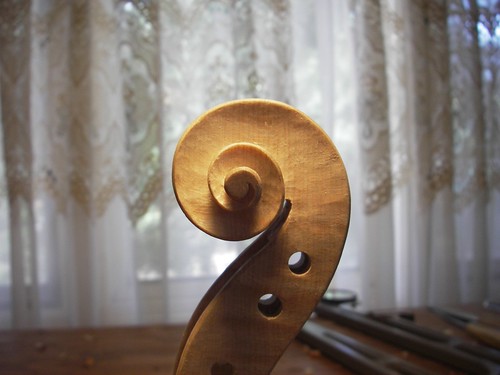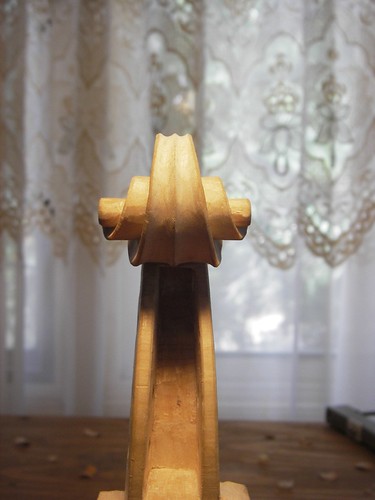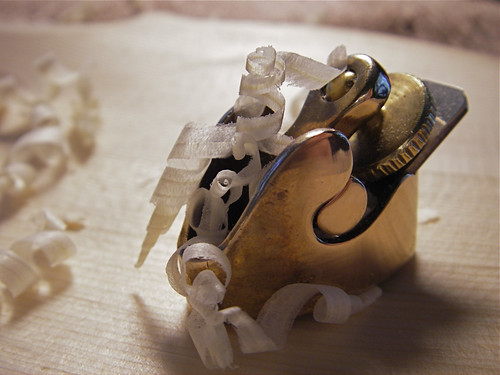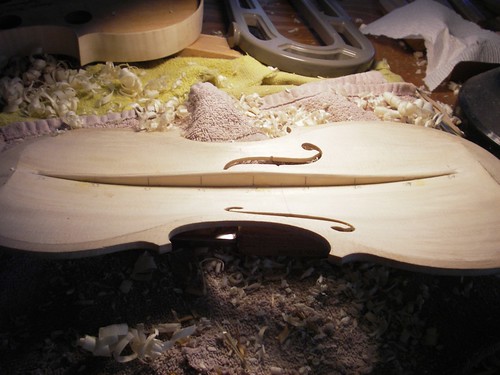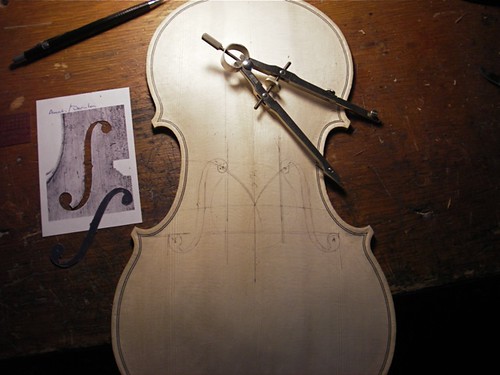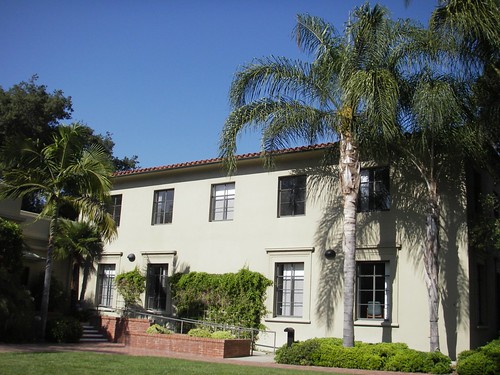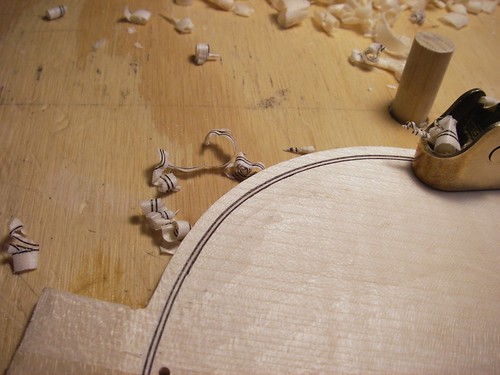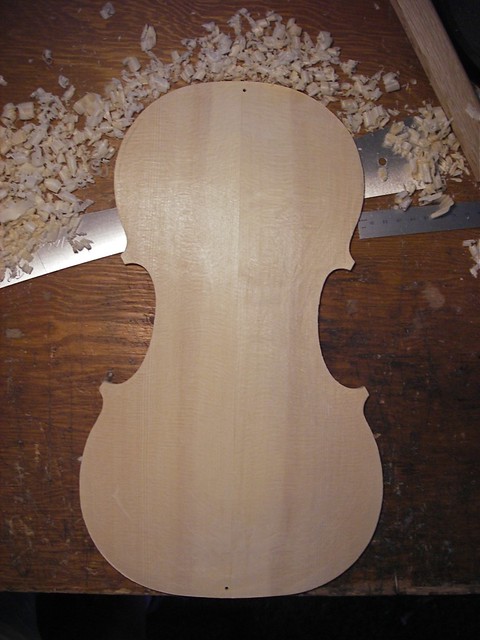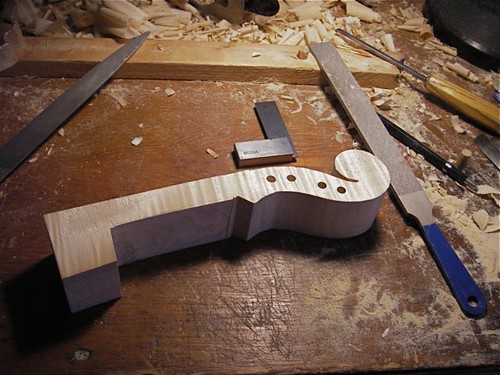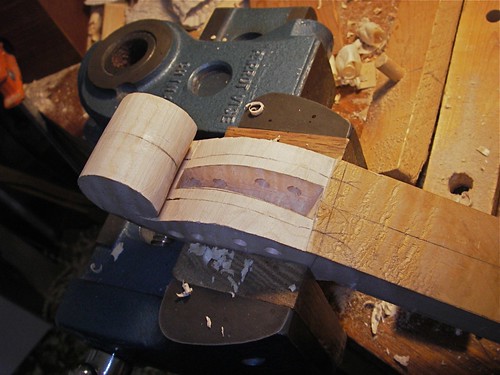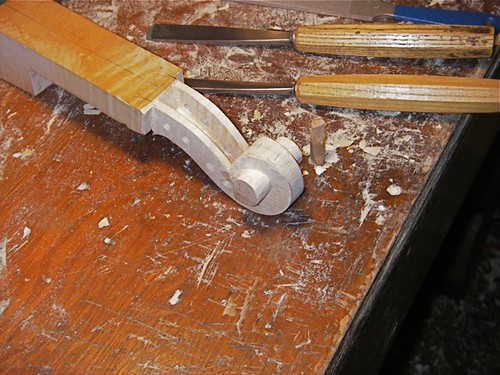Showing posts with label violin making. Show all posts
Showing posts with label violin making. Show all posts
Thursday, January 24, 2013
Jim Brown, Violinmaker in Claremont, California.
Jim Brown is the organizer of the Southern California Violin Makers Workshop, which is taught by Michael Darnton. Jim is the fellow who puts everything together, and is even the fellow who picks us students up as we come in to the airport, one-by-one, scattered throughout the day.
Here's a nice 8-minute video on Jim and his own shop.
Breathing Life.
And one of my photos of Jim giving a varnish demo at the 2008 workshop.
Wednesday, January 2, 2013
Michael Darnton (violin maker) in the News
I've attended the Southern California Violin Makers Workshop every June since 2008. Although the workshop runs for 3 weeks each June, I can only attend for one, occasionally two weeks, each year. I have a frequent conflict with the last week of the workshop as it coincides with the National Old Time Fiddlers Contest in Weiser, Idaho, where we set up shop to tend to instruments and sell a few.
Michael Darnton teaches the Violin Makers Workshop. He's a careful teacher, precise, and probably gets tired of telling me the same thing repeatedly. Eventually, however, I do learn something, so on to the next feature of making. It's also a great opportunity to meet with other makers, see their instruments, and occasionally see some really fine, old Italian fiddles.
Michael was featured recently in his local (Chicago) newspaper. Here's a video clip from that interview (newspaper as in the 21st century sense).
Violin-maker demonstrates his handmade process.
And here is a link to a scanned pdf of the print version.
Endeavor of guesswork.
It's really great for me to see Michael in action, hear his voice, be reminded of this or that part of making.
I also have my own photos from the workshop, links on the year.
2008
2009
2010
2011
2012
Thursday, July 12, 2012
Fiddle in-the-white
With all the pieces finished, it's a matter to put them together. Glueing the plates to the rib assembly (after it's been removed from the form) is fairly straight-forward. You need to be a little careful to get the overhangs reasonably uniform, and to clean up any glue that gets onto wood that will later be varnished. Setting the neck is challenging -- lots of angles to get right, nothing flat to measure against, and you can't see it all until you get it where you want it.
But, we trudge onward --
To give the wood a little character, we expose it to UV. Nowadays, most builders seem to have nice UV boxes, and I want to build one, but right now I just do it the old way -- sunlight.
We're hot these days -- 6th day in a row at 100 degrees F or over, and the skies are a bit thick with smoke from surrounding wildfires. Here's a shot of the sky a couple evenings ago, with both thunderstorm clouds and smoke.
Of course, if I get even a hint of a thunderstorm, or even wind, I bring the fiddle indoors. Not interested in that sort of antiquing!
But, we trudge onward --
To give the wood a little character, we expose it to UV. Nowadays, most builders seem to have nice UV boxes, and I want to build one, but right now I just do it the old way -- sunlight.
We're hot these days -- 6th day in a row at 100 degrees F or over, and the skies are a bit thick with smoke from surrounding wildfires. Here's a shot of the sky a couple evenings ago, with both thunderstorm clouds and smoke.
Of course, if I get even a hint of a thunderstorm, or even wind, I bring the fiddle indoors. Not interested in that sort of antiquing!
Friday, July 6, 2012
Scroll carving.
The violin scroll is that one recognizable part that everyone knows, except maybe beginning violin-makers such as myself. What does it look like anyway? To the general public, they all look the same. To experienced violin-folk, they're individual. Guarneri del Gesu's loopy asymmetric scrolls seem charming in a way the rest of us can only envy. The near perfection of Stradivari or the Amati are something we can strive for. In the meantime, those of us toiling with the scroll -- which has really no impact on the sound of the fiddle -- cut one, look at it, learn something, and resolve to do better next time.
Here's a side view of my current project, with shadows -- helps to bring out the tool marks, some of which I'll get out of the way, others I'll not see until too late or ignore because they don't bother me. Right now, there are still plenty that bother me, but I'll look at them another day.
Here's a more conventional view.
Not completely finished, but I can straighten up some of the lines tomorrow.
A non-typical view point for most folks, but for violin makers, you end up looking at the darn thing from all sorts of angles.
So, I'm not completely happy with it, but on the other hand, it will be ok, and now I can concentrate on the neck and fingerboard, which really is important to the player. Surprisingly, or perhaps not, but the neck is crucial. It's the one place on the fiddle that the player's hand comes in contact with the fiddle, and has a tremendous influence on the way a player views an instrument.
But visually, more people consider the scroll. Oh well...
Here's a side view of my current project, with shadows -- helps to bring out the tool marks, some of which I'll get out of the way, others I'll not see until too late or ignore because they don't bother me. Right now, there are still plenty that bother me, but I'll look at them another day.
Here's a more conventional view.
Not completely finished, but I can straighten up some of the lines tomorrow.
A non-typical view point for most folks, but for violin makers, you end up looking at the darn thing from all sorts of angles.
So, I'm not completely happy with it, but on the other hand, it will be ok, and now I can concentrate on the neck and fingerboard, which really is important to the player. Surprisingly, or perhaps not, but the neck is crucial. It's the one place on the fiddle that the player's hand comes in contact with the fiddle, and has a tremendous influence on the way a player views an instrument.
But visually, more people consider the scroll. Oh well...
Thursday, July 5, 2012
Glueing the top to the ribs
Getting ready to remove the form from the ribs, I clip the blocks with a chisel and mallet. This gives me a little more wiggle room.
The rib assembly is flexible yet strong. It only takes a few minutes to get the form out. I clean up the blocks most of the way before glueing the top on.
Hide glue and clamps, we starting to have a box. Always a fun point in the process. I spent some time carving the scroll today as well, and it is sitting in the background between the sharpening stone and the caliper.
Now a glass of wine is in order.
Wednesday, July 4, 2012
Finishing the inside of the top
With the outside pretty much done, it's time to finish the inside of the top. I use a big-sweep gouge to remove most of the stuff, and this goes fairly fast. Then onto thumb-planes of decreasing size. At the end, you're removing fairly thin shavings. This thumbplane has a sole length of 28-mm, or about an inch and an eighth.
I use a graduation-punch modeled after the one in the Stradivari Museum in Cremona to mark the final thicknesses. Here, the punch is a 16d nail sharpened on a grinder and the anvil is a carriage bolt with a wing-nut soldered on to allow up and down adjustment. You simply put the plate in the center, against the anvil, and lower the upper arm to press holes to the proper depth.
As we get thinner, we can use light to look for uneveness.
It's a little-known fact that Stradivari invented the incandescent lightbulb for this very purpose. At least, that's what I've heard from some violinmakers, but further research has shed some doubt an that attribution. At the very least, bright light is a good tool on new wood. The two dark bands here are stripes of denser wood showing up more and more prominently as I proceed. Wood -- you never know exactly what to expect.
When the inside is finished, the bass-bar material is then fit to the surface. Once the fit is done, it is glued in place with hide glue. Here I am using simple, old-fashioned clamps to hold the bass bar in place.
After the glue has set, the bassbar profile can be shaped.
With that, the insides are done. Next is to shape the edges, then glue the top onto the rib assembly.
I use a graduation-punch modeled after the one in the Stradivari Museum in Cremona to mark the final thicknesses. Here, the punch is a 16d nail sharpened on a grinder and the anvil is a carriage bolt with a wing-nut soldered on to allow up and down adjustment. You simply put the plate in the center, against the anvil, and lower the upper arm to press holes to the proper depth.
As we get thinner, we can use light to look for uneveness.
It's a little-known fact that Stradivari invented the incandescent lightbulb for this very purpose. At least, that's what I've heard from some violinmakers, but further research has shed some doubt an that attribution. At the very least, bright light is a good tool on new wood. The two dark bands here are stripes of denser wood showing up more and more prominently as I proceed. Wood -- you never know exactly what to expect.
When the inside is finished, the bass-bar material is then fit to the surface. Once the fit is done, it is glued in place with hide glue. Here I am using simple, old-fashioned clamps to hold the bass bar in place.
After the glue has set, the bassbar profile can be shaped.
With that, the insides are done. Next is to shape the edges, then glue the top onto the rib assembly.
Friday, June 29, 2012
Laying out and cutting f-holes
Using a few straight lines -- down the center, across the stop length (where the bridge will sit), and across at the low point of the c-bout purfling -- and circles of 32- and 64-mm, I'm trying to make the f-holes look right.
I'm using the lay-out scheme featured on Michael Darnton's website, as well as an image of a Brothers Amati f-hole he likes. Even with all that, I still end up adjusting it a bit by eye. And in doing so, hope to train my eye in the long-run. Finally, say 'good enough' and cut the holes.
At this point they've got something of the shape, but still a little too thin. How to decide that? I make them wide enough to get the soundpost through. I'm sure there must be a better criterion, but that works for now.
After a bit of clean-up work, I think I have them ok.
The poster below is of a 1666 Nicolo Amati, son of one of the Brothers Amati, and what I used as a model for my eye. Again, not a perfect copy by any means, but something I hope works and looks decent.
I'm using the lay-out scheme featured on Michael Darnton's website, as well as an image of a Brothers Amati f-hole he likes. Even with all that, I still end up adjusting it a bit by eye. And in doing so, hope to train my eye in the long-run. Finally, say 'good enough' and cut the holes.
At this point they've got something of the shape, but still a little too thin. How to decide that? I make them wide enough to get the soundpost through. I'm sure there must be a better criterion, but that works for now.
After a bit of clean-up work, I think I have them ok.
The poster below is of a 1666 Nicolo Amati, son of one of the Brothers Amati, and what I used as a model for my eye. Again, not a perfect copy by any means, but something I hope works and looks decent.
Sunday, June 24, 2012
Southern California Violin Makers Workshop 2012
June is typically a busy month for me. Since 2008, I have been attending the Southern California Violin Makers Workshop for a week, sometimes 2, and then during the third full-week in June, we have the shop set up at the National Old-time Fiddlers Contest in Weiser, Idaho.
So today I'll post about the workshop. It's held in Claremont, California, put on by Jim Brown, and taught/led by Michael Darnton of Chicago. The grounds are not too bad.
The violin-makers workshop was held on the ground-floor in this wing of the building --
while the bow-makers were across the way in this wing, behind the arched walkway --
Most of the attendees had been to the workshop before, and all (in the first two weeks) had built previous violins. Everyone was at a different place in their current violin and the atmosphere is such that we can ask questions about anything at any time. We all just set down at a bench and start working. Seeing what other people are doing, how they're doing it, the tools they're using are all wonderful ways of learning.
For me the greatest thing is that I learn so much I didn't even know to ask about.
One of my goals this time was to learn more about the outline and corners. I believe I made a major conceptual breakthrough in my understanding of corner geometry. I was never happy with the shape of my violin corners, mainly because I didn't have a clear picture in my head. Now, after years of having it presented to me, something finally clicked. It's now a matter of execution.
Towards the end of my week there, I got the purfling in both plates of my Brothers Amati fiddle.
And I spent some time working the edges down.
The workshop's official site is here. If I understand it correctly, the workshop is accepting beginners during the third week.
I have more photos of the workshop here.
Michael Darnton's website is here.
So today I'll post about the workshop. It's held in Claremont, California, put on by Jim Brown, and taught/led by Michael Darnton of Chicago. The grounds are not too bad.
The violin-makers workshop was held on the ground-floor in this wing of the building --
while the bow-makers were across the way in this wing, behind the arched walkway --
For me the greatest thing is that I learn so much I didn't even know to ask about.
One of my goals this time was to learn more about the outline and corners. I believe I made a major conceptual breakthrough in my understanding of corner geometry. I was never happy with the shape of my violin corners, mainly because I didn't have a clear picture in my head. Now, after years of having it presented to me, something finally clicked. It's now a matter of execution.
Towards the end of my week there, I got the purfling in both plates of my Brothers Amati fiddle.
And I spent some time working the edges down.
The workshop's official site is here. If I understand it correctly, the workshop is accepting beginners during the third week.
I have more photos of the workshop here.
Michael Darnton's website is here.
Thursday, May 17, 2012
Back beginnings
Usually I carve on the back first, but this time I started with the top. Now onto the back, and man, is that maple tough compared to the spruce. I cut the outline today, and started removing wood, getting towards the arching.
The silver piece in the upper left is a long arch template. I have my long arch fairly nice now, but it's still 19mm high in the center, so will need to come down a bit, more towards 16 or so.
Buried in the shavings on the upper center-right is a large gouge that I use (after the scrub plane) to remove wood fast.
In the c-bout is my large thumb plane, which actually removes a lot of wood in a hurry, too -- so much so that it actually gets quite warm to the touch.
Wednesday, May 16, 2012
Refining the edge and arching
I spent time today cleaning up the edge and the arching. For the cross-arching, I am using curtate-cycloids, which seem to follow Cremonese arching fairly well and are at the very least a practical concept for the arching. I have the edges down to about 4.5 mm, so once the edges are adequate, I can put the purfling in. First, though, I will get the back to near the same state to get the corresponding edges and overhangs somewhat coherent.
Friday, May 11, 2012
Friday, April 27, 2012
Into this neck of the wood.
Roughing out the interior of the pegbox. This goes fairly quick, but it is a work-out. I still need to clean up the edges. Lots of curl in this wood, which means it's very easy to get tear-out where you don't want it - which means I have to resharpen tools before finishing up. But another day, I need to get back to repair work.
Following, or trying to follow, a scheme by Joseph Grubaugh and Sigrun Seifert for the Brothers Amati Scroll (Strad magazine, March 2006). I'm not sure that I am interpreting the transition from flat paper to curved surface correctly, but am plunging onward.
A bit of work to cut out the sides of the pegbox and the first turn in the scroll. This highly figured wood really likes to tear out -- lots of work with the rasp!
Wednesday, April 18, 2012
An adventure in necking.

I had hoped to be much further along, but decided instead to behave like an idiot. I am working on a Brothers Amati model, based on a form I drew following Francois Denis's method. He also has a bit on drawing the scroll, but I am also trying to make progress prior to the So. California workshop in June, so I was trying to save a little time.
I did have a Strad magazine poster of a 1666 Nicolo Amati violin, which has a very similar body to the Bros. Amati outline, so my plan was simple. Scan the scroll part of the poster, print it out, glue it on to a generic neck outline. Close enough for now.
I have a new-to-me computer. The scanner is a few years old. It works fine. I scanned the poster. Print out the scan, and it's huge. Go back to the software, adjust settings, resize the image. After 3 or 4 tries, I have it pretty close to the poster image.
This is a Strad poster from 1996.
I try splicing the scanned scroll onto the neck. Hmmm. It looks a little big. Maybe a lot big. Back to comparing with the poster. Same size. Hmmm. Finally (duh!) I turn the poster over and read the measurements.
Strad magazine has gotten a lot better on their posters over the years. I do remember, however, being cautioned that the photos are not always accurate to size and one should check the measurements against the photo.
That is actually a very good idea.
The poster's scroll was, from heel to end of the scroll, a cm longer than the real thing. Not enough for me to notice out-of-context.
So, back to the drawing-board (computer). A few more re-scaling attempts and I get something that is reasonably close. Attach it to the neck template. Glue it to thin metal. Cut it out, file down the edges.
Not enough time today to mark-out or cut the scroll, but I'm sure ready for tomorrow.
Unless some other conceptual problem pops up.
Saturday, March 24, 2012
Squaring a neck.
I was squaring up a block for the neck this morning before breakfast, just getting a little done while waiting for the rest of the house to get going. This was a rather plain looking block, didn't cost all that much, and didn't seem to nice -- but after removing a little wood, it had quite a nice sheen to it, as well as some nice figure.
Don't know if it will match the back I have for this one, which I think is rather plain, but the ribs are flamed, so a mongrel it will be.
Thursday, March 22, 2012
One small step -- joining a top.
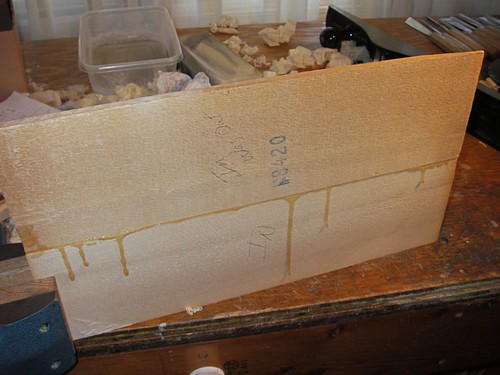
I have been so busy with work lately that I haven't had a breath of time to work on my own instruments. Today, I finally said to heck with it and joined a top. It has been since the end of November when I've done anything towards my Amati Bros. form -- so now I have a top to work with. Small victory, but still a victory.
Saturday, March 17, 2012
1737 Geometrical Construction Error
I have just started reading “Architecture and Geometry in the Age of the Baroque” by George L. Hersey, which was recommended as another good book into the theoretical mind of the time -- connecting music and architecture.
In the book, on pg 16, is Guarino Guarnini’s scheme for drawing a Golden-section rectangle, published in 1737.
There was a clear typo in the text, where
CH:FH :: FH:FA
should have read
CF:FH :: FH:FA
Or at least it seemed obvious to me, then I wasn’t so sure, so I thought, heck, I’ll just do the construction, then measure and calculate the resulting ratios. I tried it 3 or 4 times. Expecting to get 1.618, I was surprised to get 1.73 or 1.74. What the heck is going on? So I did the quick theoretical calculation -- maybe where I should have started -- and found that the ratio from this construction is actually the square root of 3, or about 1.73.
Guarnini’s method is/was wrong. And here it was being presented in an architecture text written in 2000 as being correct. And then, perhaps, in a subsequent edition, there is a footnote (14) that presents the error, though it is not corrected in the text itself.
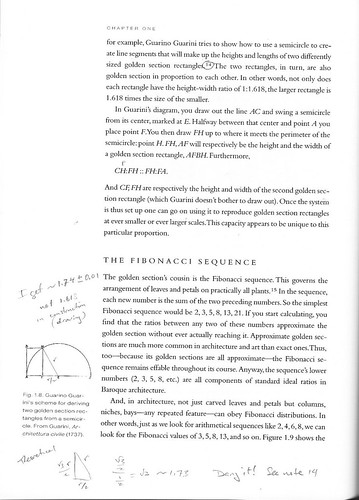
Tuesday, November 29, 2011
Linings, or slotting the hedgehog
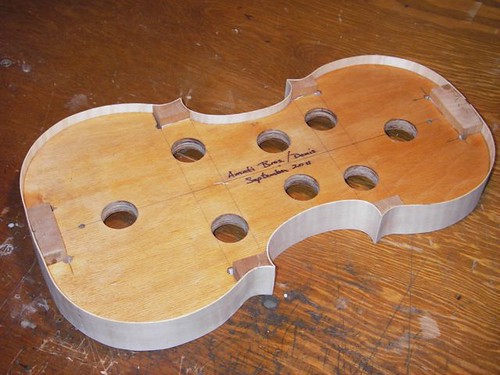
With all the ribs bent and glued to the blocks, it's time to get the linings installed. Linings add strength to the ribs as well as increasing the gluing surface for the top and back seams.
Working down willow for linings is cheap thrills indeed -- it's always fun to peal off some long shavings. The linings are thinned to about 2 mm, bent, and inlet in to the corner blocks at the c-bouts.
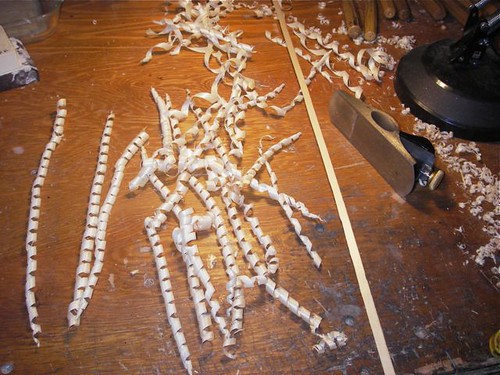
The linings glued in on the top edge of the ribs, held in place with clothes pins reinforced with rubber bands -- fancy stuff indeed. Looks something like a porcupine or hedgehog with all the clamps in place. "Slotting the hedgehog" -- an old obscure violin-makers' phrase, perhaps something like this, perhaps not.
After the glue sets up overnight, I'll have to do the same thing to the bottom of the ribs. It's not a terrible task at all.
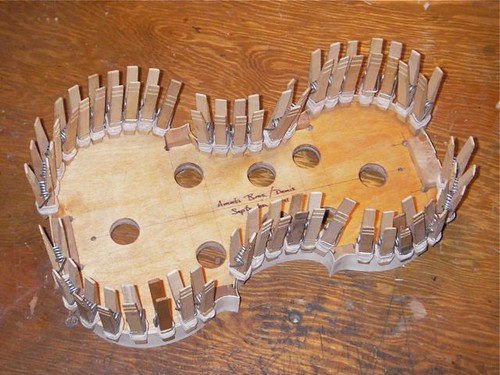
Wednesday, November 16, 2011
Two-thirds of the ribs in place.

I put the c-bouts in, then the upper bouts. This is the first time I'm seeing ribs on this form, and the compass arcs (from the drawing) really show up in the upper ribs, nice and round. I'm curious to see what the lower bouts look like with ribs in place.
If you didn't see it before and are wondering about the drawing of the form, my blog posts on that start here.
Saturday, November 12, 2011
Planing rib-stock to thickness
Friday, October 14, 2011
Blocks on the Amati Bros. form & a 'new' plane

A chunk of willow from a local blow-down, well-aged by now, a big chisel to split the wood, a plane and square to fit them up.
The corner blocks squared on 4 sides, the two ends squared on 5 sides, ready to be glued onto the form. The nails are put in the form to hold the metal template for marking out the rib-sides (the not squared sides) of the blocks.

I'm using bottled hide-glue to hold the blocks in place. I bought a bottle of it recently to use for spot gluing the spreader wedge when rehairing bows. This is the first time I've used it for this purpose, but I don't go through a bottle very fast, and it does have a finite life.

A new-to-me tool, a Stanley No. 40 scrub plane.

I used one of these over 2 years ago at the Southern California Violin Makers Workshop, and was really impressed with it for removing wood from the outsides of the plates -- it's basically a gouge held in a plane body. I've missed a few on eBay, but recently set my mind to getting one. I am no expert at dating these, and am happy to stand corrected, but it appears to match those made around 1890. The forward tote appears to be a replacement. It could use a little cleaning up and fine tuning, but works as is.
Subscribe to:
Posts (Atom)






